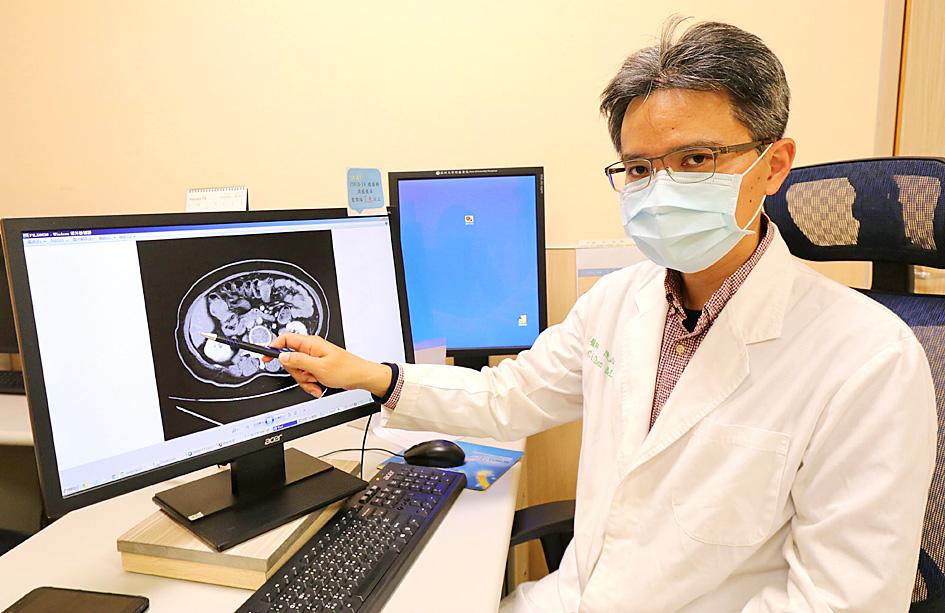Red spots on the palm of the hand could be sign of liver cancer, a Taichung-based doctor said on Thursday.
Liver cancer is rarely detected in the early stages, when medical intervention is most likely to succeed, said Chen Cheng-kuo (陳政國), a gastroenterologist at Asia University Hospital.
This is because the liver lacks pain receptors, making it necessary to look for other symptoms to detect the disease, he said.

Photo: Chen Chien-chih, Taipei Times
Symptoms include “liver palms,” which refers to red patches or spots at the base of the thumb, spidery lines of inflamed capillaries that radiate from blemishes on the chest or in the extremities, and jaundice, he said.
Varicose veins on the abdomen, and swelling in the hands and feet are also signs of liver disease, including cancer, Chen said.
Citing an example, he said a 64-year-old woman surnamed Chao (趙) was recently brought to the hospital by her daughter who suspected her mother might have cancer after seeing red spots on Chao’s palms.
Ultrasound and magnetic resonance imaging scans detected a liver tumor, which was surgically removed, he said, adding that the woman is now in recovery.
People with hepatitis B or C should regularly undergo checkups, as the disease is closely related to cirrhosis and liver cancer, Chen said.
A 1cm liver tumor can triple its size in four to six months and metastasize in a year, he said.
This means people with hepatitis B or C should undergo a checkup every four to six months, he added.

Taiwan is to commence mass production of the Tien Kung (天弓, “Sky Bow”) III, IV and V missiles by the second quarter of this year if the legislature approves the government’s NT$1.25 trillion (US$39.78 billion) special defense budget, an official said yesterday. Commenting on condition of anonymity, a defense official with knowledge of the matter said that the advanced systems are expected to provide crucial capabilities against ballistic and cruise missiles for the proposed “T-Dome,” an advanced, multi-layered air defense network. The Tien Kung III is an air defense missile with a maximum interception altitude of 35km. The Tien Kung IV and V

The disruption of 941 flights in and out of Taiwan due to China’s large-scale military exercises was no accident, but rather the result of a “quasi-blockade” used to simulate creating the air and sea routes needed for an amphibious landing, a military expert said. The disruptions occurred on Tuesday and lasted about 10 hours as China conducted live-fire drills in the Taiwan Strait. The Civil Aviation Administration (CAA) said the exercises affected 857 international flights and 84 domestic flights, affecting more than 100,000 travelers. Su Tzu-yun (蘇紫雲), a research fellow at the government-sponsored Institute for National Defense and Security Research, said the air

Taiwan lacks effective and cost-efficient armaments to intercept rockets, making the planned “T-Dome” interception system necessary, two experts said on Tuesday. The concerns were raised after China’s military fired two waves of rockets during live-fire drills around Taiwan on Tuesday, part of two-day exercises code-named “Justice Mission 2025.” The first wave involved 17 rockets launched at 9am from Pingtan in China’s Fujian Province, according to Lieutenant General Hsieh Jih-sheng (謝日升) of the Office of the Deputy Chief of the General Staff for Intelligence at the Ministry of National Defense. Those rockets landed 70 nautical miles (129.6km) northeast of Keelung without flying over Taiwan,

A strong continental cold air mass is to bring pollutants to Taiwan from tomorrow, the Ministry of Environment said today, as it issued an “orange” air quality alert for most of the country. All of Taiwan except for Hualien and Taitung counties is to be under an “orange” air quality alert tomorrow, indicating air quality that is unhealthy for sensitive groups. In China, areas from Shandong to Shanghai have been enveloped in haze since Saturday, the ministry said in a news release. Yesterday, hourly concentrations of PM2.5 in these areas ranged from 65 to 160 micrograms per cubic meter (mg/m³), and pollutants were